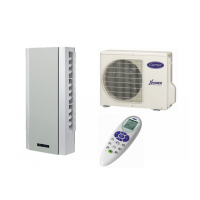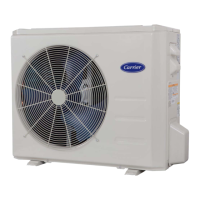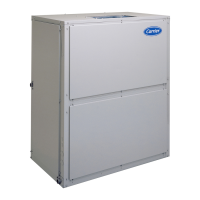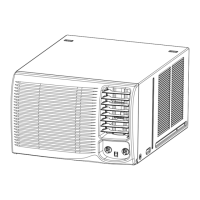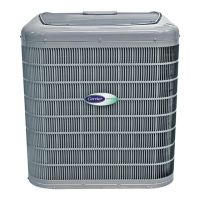R4A4S, R4A5S: Installation Instructions
Manufacturer reserves the right to change, at any time, specifications and designs without notice and without obligations.
5
Air Conditioner Applied as Replacement Component
If the air conditioner is installed as a replacement component in an
existing piston indoor system, the piston size in the indoor unit should be
changed to the size required for the air conditioner which can be found in
the indoor unit Product Data
Units with Cooling Mode TXV
Units installed with cooling mode TXV require charging by the
subcooling method.
1. Operate unit a minimum of 15 minutes before checking charge.
2. Measure liquid service valve pressure by attaching an accurate gage
to service port.
3. Measure liquid line temperature by attaching an accurate thermistor
type or electronic thermometer to liquid line near outdoor coil.
4. Refer to unit rating plate for required subcooling temperature.
5. Refer to Table 2 - Rating Plate (required) Subcooling Temperature.
Find the point where required subcooling temperature intersects
measured liquid service valve pressure.
6. To obtain required subcooling temperature at a specific
liquid line pressure, add refrigerant if liquid line temperature is
higher than indicated or reclaim refrigerant if temperature is lower.
Allow a tolerance of ±3°F (±1.7°C).
Units with Indoor Piston
Units installed with indoor pistons require charging by the superheat
method.
The following procedure is valid when indoor airflow is within ±21
percent of its rated CFM.
1. Operate unit a minimum of 15 minutes before checking charge.
2. Measure suction pressure by attaching an accurate gage to suction
valve service port.
3. Measure suction temperature by attaching an accurate thermistor
type or electronic thermometer to suction line at service valve.
4. Measure outdoor air dry-bulb temperature with thermometer.
5. Measure indoor air (entering indoor coil) wet-bulb temperature
with a sling psychrometer.
6. Refer to Table 3 - Superheat Charging - AC Only. Find outdoor
temperature and evaporator entering air wet-bulb temperature. At
this intersection, note superheat. Where a dash (--) appears on the
table, do not attempt to charge system under these conditions or
refrigerant slugging may occur. Charge must be weighted in, adding
or removing 0.6 oz/ft of 3/8 liquid line above or below 15 feet
(4.6m) respectively.
7. Refer to Table 4 - Required Suction-Line Temperature. Find
superheat temperature (from #6 above) and suction pressure. At this
intersection, note suction line temperature.
8. If unit has a higher suction line temperature than charted
temperature, add refrigerant until charted temperature is reached.
9. If unit has a lower suction line temperature than charted
temperature, reclaim refrigerant until charted temperature is
reached.
10. When adding refrigerant, charge in liquid form into suction service
port using a flow-restricting device.
11. If outdoor air temperature or pressure at suction valve changes,
charge to new suction line temperature indicated on chart.
12. Optimum performance will be achieved when the operating charge
produces 10°F suction superheat at suction service valve with 95°F
(35°C) outdoor ambient and 80°F (27°C) dry bulb (67°F / 19°C)
wet bulb) indoor temperature (DOE “A” test conditions) at rated
airflow.

